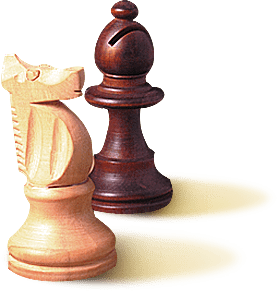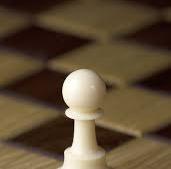
2 Ns vs 2 Bs
For more cool articles visit http://stuscorner.wordpress.com
This article will help players to understand how to play against two Bs when you have two Ns. Battle of 2 Bs vs 2 Ns doesn’t occur frequently, but if you are fond of, for example, Chigorin defence ( one of my favorites ) then you should know this stuff.
Lasker, Emanuel – Chigorin, Mikhail, Hastings 1895

This position was covered by Shereshevsky in his fantastic book “Strategy of Endgames”, but we will analyse the position from a different angle.
Black’s last move was 15..O-O. We can safely say that White has a big egde, he has two semi-open files, a very strong center and a pair of long-ranged monsters. It’s a well known fact that unbalanced pawn structures are good for two Bs thanks to the fact that such structures contain a lot of potential; for example, creating a passed pawn should not be a difficult task if you have 3 pawns facing 2 pawns on one wing. Here White is a bit far away from that, but he can use his pawns to make more space for his Bs.
As we know, Bs like open positions; currently his Bs are not doing a lot, but this can change easily once White sets his pawn on f5 square.
16.Ke2 ( diagram )

Let’s see this position from Black’s perspective…what a grim site in front of us! He is cramped by chains of passivity, without any counterplay, he has nothing to attack, nothing concrete to do. Having in mind White’s positional plusses, the pictures gets even uglier…and yet Black won the game.
Chigorin Defence features one important positional concept; Black is obligated to create and maintain the central tension, usually by playing either ..c5 or ..e5, or both.
16..Rc8! 17.Rg3 c5 ( diagram )

The only way to continue. Black cannot create tension in this position simply because he hasn’t got any strenght to do that because White’s d4 is well protected, but he can try to block this position.
18.Rag1?
Is a huge mistake. 18.f5 was doing just fine, and was enough for a big edge.
18..c4! 19.Bc2 f5! ( diagram )

Completely turning the tables! Black’s days of misery are behind him and his future looks really bright. Compare this position to the first diagram, and tell me what can you spot? Well, the Bs are still inactive, but back then White had a way of employing them, something which cannot be said here. White’s center has lost mobility since c4 and f5 are no longer valid options, the only way to get the pawns going would be f3 followed by e4, but having in mind the potential weakness of pawn on f4, this scenario cannot be seriously considered; after all, pawn on f4 cannot be defended by his collegue.
So, what happened, why was 19..f5 so strong? We know that Ns are fond of closed position, and 18..c4 combined with 19..f5 achieved that, and White is unable to open up this position any more.
But let’s dig a bit deeper, we can spot that Black has created a very nice landing spot for his Ns: d5 square. In this first diagram the square was not particularly attractive, as c4 was just around the corner. Here, well, thanks to 18th move, Black secured the square for his Ns. The only way of regaining control over the square would be f3-e4, but if you rewind the film a bit, you will remember my story about potentially weak pawn on f4.
Finally, we can draw the conclusion: two Ns can fight back only if they can occupy good squares which cannot be controlled by opponent’s pawns and which are controlled by our pawns. The last thought is pure gold; a N has to be guarded by a pawn, otherwise a B will be able to kick the N out.
One can object and say “I don’t know, I’d rather skip 19..f5, as it creates the weakness on e6.” A partial credit for that, the move is a commiting move but pawn e6 is not a weakness! In order to turn e6 pawn into a weak pawn, White has to attack it, but can he really do it in this position? If so, how?
So, only by attacking one can highlight minuses in opponent’s camp and turn opponent’s pawns or pieces into weaknesses, but until that happens, weakness doesn’t really exist! I might have an isoliani but does it really matter if you are not attacking the pawn? I might have a bad N that is about to get trapped but who cares when I’m about to mate my opponent?
Plus, in this concrete position Black had no choice, his choice was:
- to play something else and allow to get squashed after White’s f5 or
- to play 19..f5 and enjoy himself.
Unless you are a guy with suicidal tendencies, the choice should not be too difficult.
20.Bc1 Rf7 21.Ba3 Rc6 22.Bc5 Ra6 23.a4 Nc6 24.Rb1 Rd7 25.Rgg1 Nge7 26.Rb2 Nd5 27.Kd2 Ra5 28.Rgb1 b6 29.Ra3 g6 ( diagram )

White is totally disoriented and pretty much desperate, as he is unable to open this position up. On the other hand, Black is having a wonderful time: he has anchored his N on d5, and one of his Rooks is taking care of White’s temporary activity on the Q-side. Just compare this position to the position before 18..c4, since then Black has played normal chess, nothing fancy, nothing tricky, and yet his position has improved dramatically.
Since White has dwelled into passivity, Black should start thinking how to improve his position even more; going back and forth never works because your opponent will not do the same, you constantly have to work on improving your position.
30.Rb5 Ra6 31.Bc1 Nd8 32.Ra1 Nf7 33.Rbb1? ( diagram )

And here we have to stop because the next move is a food for thought, and is out of scope of this article, so we will discuss it some other time...
Now let’s see what happens when Black goes astray, when he fails to set up a good blockading construction.
Palac, Mladen – Bukal Vladimir, Valle d’Aosta, 2002

Black is a pawn up but he is pretty much in bad shape; in order to prove that his extra pawn is worth something, he has to roll his Q-side up the board, but seeing this huge pressure down the b-file and h1-a8 diagonal, we can say that the plan will never succeed, ever. Not even then! Black is totally unable to deal with the pressure, in order to move ..b6 he has to move his N on c6 first, but how to do it when White will start pressing down the c-file soon? Perhaps solving the problem of pawn c7 first, and then focusing on moving Nc6 and eventually ..b6? Not happening, this would mean that Black will neglect White’s central mass which will allow him to play e4-e5-d5 totally pushing Black off the board. The only way to save this shafted position would be making the block on either e4 or d5 square, but we will see that Black has no time for it.
14..Rfe8 15.Qc1 Qe6 16.Rd1 ( diagram )

Black cannot play 16..Nd5 hoping to continue with 17..f5 because Qc5-Rb5 plan would put a monster-like pressure on d5.
16..Ne4 17.Be1 ( diagram )

Now the fork is the threat.
17..Ne7 18.f3!
Of course not 18.Qxc7? Nd5 19.Qc2 f5 with a fine position because Black has managed to establish a strong central
blockade.
18..Nd6 19.e4 c6 20.f5 Qd7 21.Bg3 ( diagram )

Total triumph of White’s strategy, it’s impossible to advise Black.
21..b6 22.f6! Ng6 23.fxg7 Kxg7 24.e5 Nb7 25.f4 ( diagram )

With an overwhelming position, Black lost soon.
To summarise:
- two Ns can fight back only if they can occupy good squares which cannot be controlled by opponent’s pawns and which are controlled by our pawns; a N has to be guarded by a pawn, otherwise a B will be able to kick the N out
- one can highlight minuses in opponent’s camp and turn opponent’s pawns or pieces into weaknesses only by attacking, but until that happens, weakness doesn’t really exist
- going back and forth never works because your opponent will not do the same, you constantly have to work on improving your position.
Questions? :)






